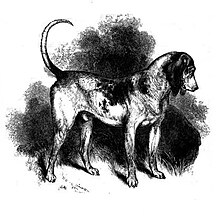
The beagle is a breed of small hound that is similar in appearance to the much larger foxhound. The beagle is a scent hound, developed primarily for hunting hare (beagling). Possessing a great sense of smell and superior tracking instincts, the beagle is the primary breed used as detection dogs for prohibited agricultural imports and foodstuffs in quarantine around the world. The beagle is intelligent. It is a popular pet due to its size, good temper, and a lack of inherited health problems.

The Harrier is a medium-sized dog breed of the hound class, used for hunting hares by trailing them. It resembles an English Foxhound but is smaller, though not as small as a Beagle.

A hound is a type of hunting dog used by hunters to track or chase prey.

Scent hounds are a type of hound that primarily hunts by scent rather than sight. These breeds are hunting dogs and are generally regarded as having some of the most sensitive noses among dogs.

The Black and Tan Coonhound is a breed of hunting dog. Developed in the United States from crosses between the Bloodhound and the Black and Tan Virginia Foxhound, this scent hound runs its game entirely by scent and is used primarily for raccoon hunting.

Beagling is the hunting mainly of hares and also rabbits, but definitely not foxes, by beagles by scent. A beagle pack is usually followed on foot, but in a few cases mounted. Beagling is often enjoyed by 'retired' fox hunters who have either sustained too many injuries or lost the agility to ride horseback, or who enjoy the outdoors and the camaraderie of the hunt. It is also traditionally a way for young men and women to learn how to handle hounds on a smaller scale before they go on to hunt with foxhounds.

The Otterhound is a British dog breed. It is a scent hound and is currently recognised by the Kennel Club as a Vulnerable Native Breed with around 600 animals worldwide.
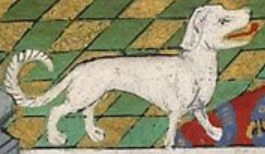
The Talbot was a type of hunting hound common in England during the Middle Ages. It is depicted in art of the period as small to medium-sized, white in colour, with short legs, large powerful feet, a deep chest with slender waist, long drooping ears, and a very long curled tail. It is shown in one well-known example at Haddon Hall with a fierce facial expression. It is now extinct but is believed to be an ancestor of the modern beagle and bloodhound. It is uncertain whether it was a scent hound, a sight hound, or a dog used for digging out quarry. Nor is it known what type of quarry it hunted, whether deer, fox, boar, etc.

The American Foxhound is a breed of dog that is a cousin of the English Foxhound. They are scent hounds, bred to hunt foxes by scent.

The English Foxhound is one of the four foxhound breeds of dog. It is a cousin of the American Foxhound. They are scent hounds, bred to hunt foxes by scent.
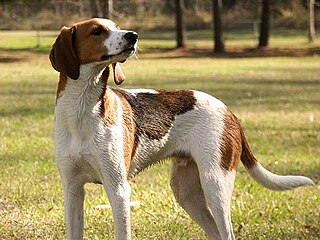
The Treeing Walker Coonhound is a breed of hound descended from the English and American Foxhounds. The breed originated in the United States when a dog known as "Tennessee Lead" was crossed into the Walker Hound in the 19th century. The Treeing Walker Coonhound was recognized officially as a breed by the United Kennel Club in 1945 and by the American Kennel Club in 2012.
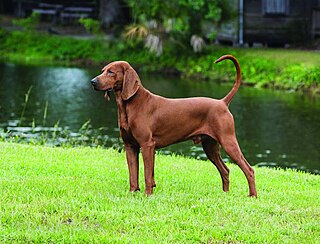
The Redbone Coonhound is an American breed of hunting dog. It may be used to hunt raccoon, deer, bear, boar, cougar, or other large game. It originated in the Southern United States, and derives from foxhounds brought by immigrants from Scotland. It is characterized by its deep red coat.

The Kerry Beagle is one of the oldest Irish hound breeds, believed to be descendant from the Old Southern Hound or the Celtic Hounds. It is the only extant scent hound breed native to Ireland.
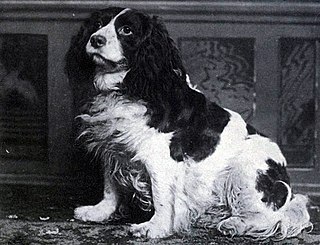
The Norfolk Spaniel or Shropshire Spaniel is an extinct breed of dog since the early 20th century. It was originally thought to have originated from the work of one of the Dukes of Norfolk, but this theory was disproven after being in doubt during the later part of the 19th century. The term was used to designate springer type spaniels that were neither Sussex nor Clumber Spaniels, and attempts were made to use it to specify a breed that would later become known as the English Springer Spaniel.

The North Country Beagle, Northern Hound or Northern Beagle was a breed of dog that existed in Britain probably until early in the 19th century. The exact date of its extinction is not known; it is likely that it was gradually interbred with other breeds, particularly the modern Beagle, until the genuine North Country Beagle bloodline ceased to exist.

Dog types are broad categories of domestic dogs based on form, function or style of work, lineage, or appearance. Some may be locally adapted dog types that may have the visual characteristics of a modern purebred dog. In contrast, modern dog breeds strictly adhere to long established breed standards, that began with documented foundation breeding stock sharing a common set of inheritable characteristics, developed by long established, reputable kennel clubs that recognize the dog as a purebred.

The Bloodhound is a large scent hound, originally bred for hunting deer, wild boar and, since the Middle Ages, for tracking people. Believed to be descended from hounds once kept at the Abbey of Saint-Hubert, Belgium, it is known to French speakers as le chien de Saint-Hubert. A more literal name in French for the bloodhound is le chien de sang.
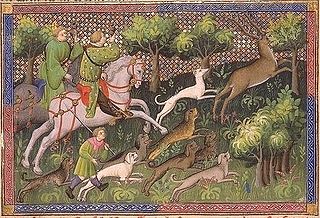
Rache, also spelled racch, rach, and ratch, from Old English ræcc, linked to Old Norse rakkí, is an obsolete name for a type of hunting dog used in Great Britain in the Middle Ages. It was a scenthound used in a pack to run down and kill game, or bring it to bay. The word appears before the Norman Conquest. It was sometimes confused with 'brache', which is a French derived word for a female scenthound.
A limer, or lymer, was a kind of dog, a scenthound, used on a leash in medieval times to find large game before it was hunted down by the pack. It was sometimes known as a lyam hound/dog or lime-hound, from the Middle English word lyam, meaning 'leash'. The French cognate limier has sometimes been used for the dogs in English as well. The type is not to be confused with the bandog, which was also a dog controlled by a leash, typically a chain, but was a watchdog or guard dog.

The Poitevin, also known as the Chien de Haut-Poitou, is a breed of French scenthound from the province of Poitou, this predominantly pack hound was created in the 17th century to hunt wolves.
